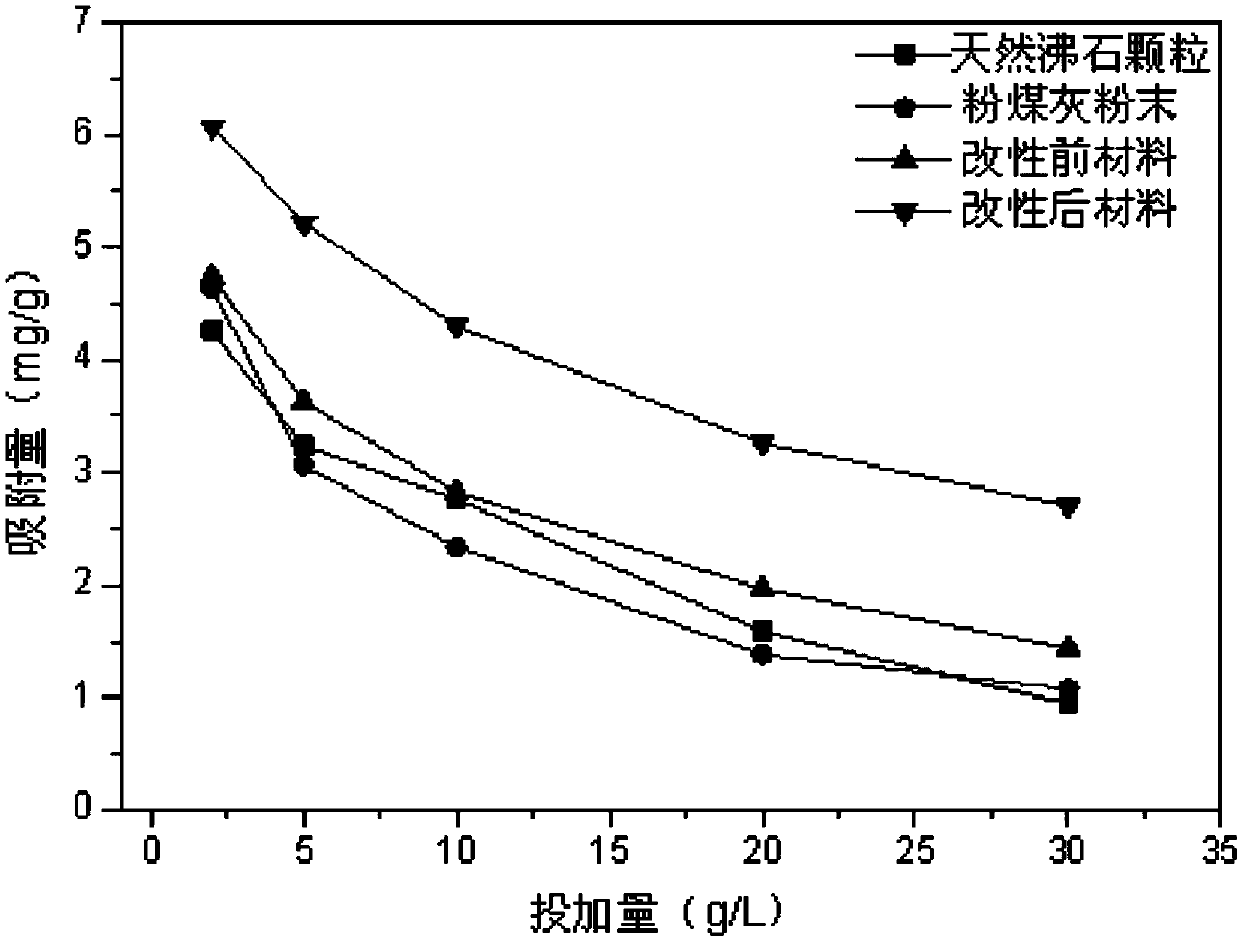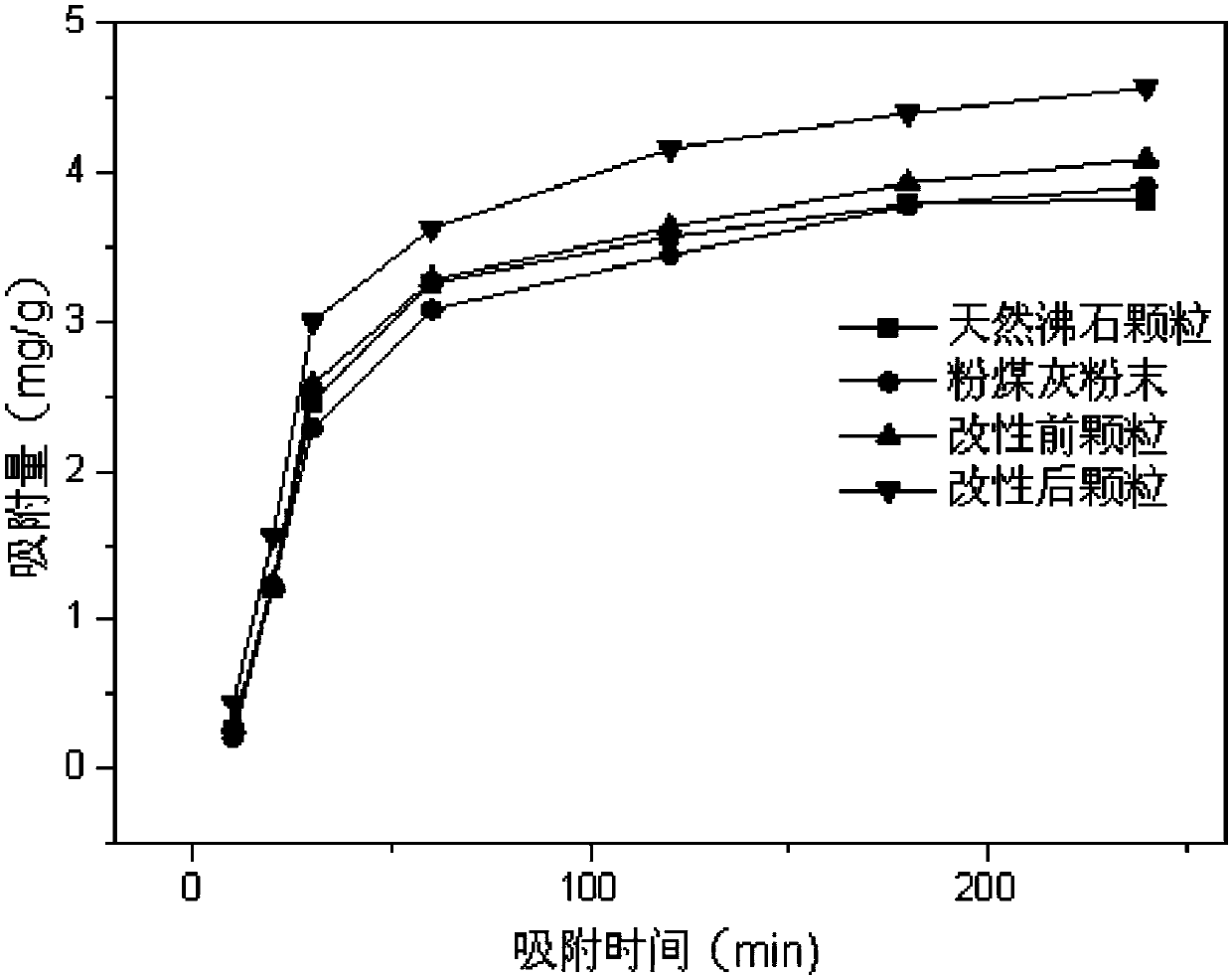Porous adsorbing material, oxygen-carrying and adsorbing composite functional material, and application of porous adsorbing material and oxygen-carrying and adsorbing composite functional material
A technology of porous adsorption material and matrix material, applied in the field of water body remediation materials, can solve the problems of reduced water body transparency, unsustainability, decline of aquatic animals and plants, etc., and achieves the effect of improving water body dissolved oxygen, good oxygen-carrying performance and water quality.
- Summary
- Abstract
- Description
- Claims
- Application Information
AI Technical Summary
Problems solved by technology
Method used
Image
Examples
Embodiment 1
[0056] A kind of porous adsorption material is prepared according to the following steps:
[0057] 1) Wash natural zeolite, bentonite and fly ash with deionized water respectively, dry at 105°C, grind through a 50-mesh sieve, and set aside;
[0058] Get the zeolite, bentonite, and fly ash after the above-mentioned treatment and add aluminum chloride aqueous solution respectively, the solid-liquid ratio is respectively 1:5 (solid unit is g, liquid unit is ml), the concentration of used aluminum chloride aqueous solution is 1mol / L, pH is 8, oscillating and impregnating at 95°C for 24h, filtering, cooling the obtained residue, and drying; add sodium hydroxide aqueous solution to the dried material, and its solid-liquid ratio is 1:5 (solid unit is g, liquid unit is ml ), the concentration of the aqueous sodium hydroxide solution used is 1mol / L, shake and impregnate for 24h, filter, cool the gained solid, dry, and set aside;
[0059] 2) Take step 1) modified zeolite, bentonite an...
Embodiment 2
[0064] In this example, zeolite and fly ash were used to modify porous adsorption materials and oxygen-carrying + adsorption composite functional materials, and the porous adsorption materials were prepared according to the following steps:
[0065] 1) Natural zeolite, bentonite, and fly ash were washed with deionized water respectively, dried at 105°C, ground through a 100-mesh sieve, and set aside;
[0066] Get the zeolite, bentonite, and fly ash after the above-mentioned treatment and add aluminum chloride aqueous solution respectively, the solid-liquid ratio is respectively 1:6 (solid unit is g, liquid unit is ml), the concentration of used aluminum chloride aqueous solution is 2mol / L, the pH is 8, 95 ℃ shaking impregnation for 24h, filtering, cooling the obtained residue, and drying; add sodium hydroxide aqueous solution to the dried material, and its solid-liquid ratio is 1:6 (solid unit is g, liquid unit is ml ), the concentration of the aqueous sodium hydroxide soluti...
Embodiment 3
[0072] In this example, zeolite and fly ash were used to modify porous adsorption materials and oxygen-carrying + adsorption composite functional materials, and the porous adsorption materials were prepared according to the following steps:
[0073] 1) Natural zeolite, bentonite, and fly ash were washed with deionized water respectively, dried at 105°C, ground through a 150-mesh sieve, and set aside;
[0074] Get the zeolite, bentonite, and fly ash after the above-mentioned treatment and add aluminum chloride aqueous solution respectively, and its solid-liquid ratio is respectively 1:7 (solid unit is g, liquid unit is ml), and the concentration of aluminum chloride aqueous solution used is 3mol / L, pH is 7, oscillating and impregnating at 95°C for 24h, filtering, cooling the obtained residue, and drying; adding sodium hydroxide aqueous solution to the dried material, and its solid-liquid ratio is 1:7 (solid unit is g, liquid unit is ml), the concentration of aqueous sodium hyd...
PUM
| Property | Measurement | Unit |
|---|---|---|
| pore size | aaaaa | aaaaa |
| particle size | aaaaa | aaaaa |
| diameter | aaaaa | aaaaa |
Abstract
Description
Claims
Application Information
 Login to View More
Login to View More - R&D
- Intellectual Property
- Life Sciences
- Materials
- Tech Scout
- Unparalleled Data Quality
- Higher Quality Content
- 60% Fewer Hallucinations
Browse by: Latest US Patents, China's latest patents, Technical Efficacy Thesaurus, Application Domain, Technology Topic, Popular Technical Reports.
© 2025 PatSnap. All rights reserved.Legal|Privacy policy|Modern Slavery Act Transparency Statement|Sitemap|About US| Contact US: help@patsnap.com



